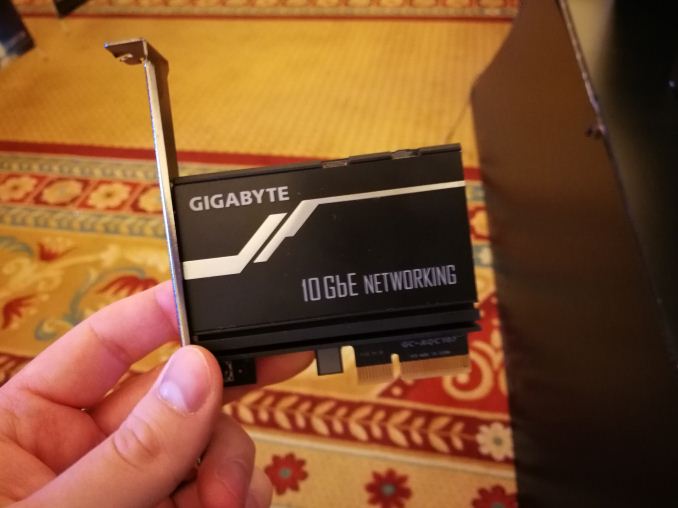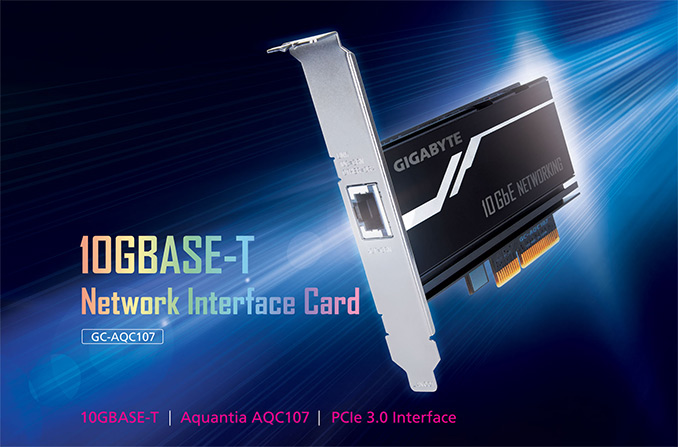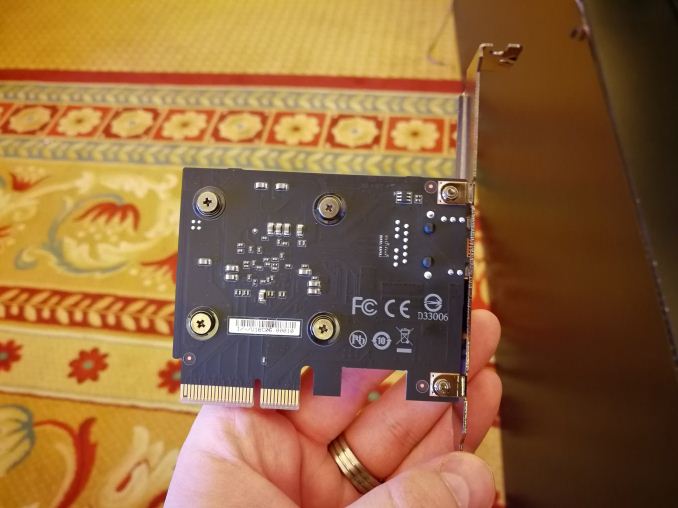GIGABYTE’s GC-AQC107 10G Ethernet PCIe Card Launched and Listed
by Anton Shilov on November 9, 2017 4:00 PM EST
GIGABYTE has added the GC-AQC107 10 GbE PCIe card it demonstrated early this year at CES to the list of products on its website. The product is also listed on both Amazon US and Amazon UK but is currently unavailable. When the network card is released, GIGABYTE will be the third company to offer a 10 GbE NIC based on an Aquantia chip.
The GIGABYTE GC-AQC107, powered by the Aquantia AQtion AQC107 controller, supports 100M, 1G, 2.5G, 5G and 10G networking standards over CAT5e or CAT6/6a cables and RJ45 connectors (depending on the distance). The card resembles Aquantia’s reference design, so it is not considerably different from 10 GbE boards from Aquantia itself. To ensure that the AQC107 chip does not overheat, GIGABYTE equipped the GC-AQC107 with an aluminum heatsink. Furthermore, to make it easier for consumers to set up their networks, the RJ45 connector features LEDs monitoring data transmission. As for requirements, the GC-AQC107 can be installed into any modern PC that has a spare PCIe x4 slot and is running Microsoft Windows 7 and higher, as well as various Linux operating systems.
| GIGABYTE 10GBase-T Card for Consumers | |
| GC-AQC107 | |
| Controller | Aquantia AQC-107 |
| 100BASE-T | Yes |
| 1000BASE-T | Yes |
| 2.5GBASE-T | Yes |
| 5GBASE-T | Yes |
| 10GBASE-T | Yes (over Cat6 cables) |
| Ports | 1 |
| Price | unknown |
| Release Date | Q4 2017 |
| Additional Information | Link |
The listing on the official website, as well as on Amazon, indicates that the GC-AQC107 will be available shortly. An important question surrounding the card is how much will it cost. Aquantia’s MSRP for its own AQN-107 card is $127, but ASUS charges $99 for its 10 GbE NIC based on the AQC107, so expect the GIGABYTE GC-AQC107 to cost between $99 and around $130.
Meanwhile, a quick check of leading U.S. retailers revealed that 10 GbE-supporting switches are still quite expensive and the most affordable one is the ASUS XG-U2008 10GBase-T that is available for $220 from Amazon and Newegg.
Related Reading
- GIGABYTE Exhibits an Aquantia AQC107 based 10G Ethernet PCIe Card
- ASUS Launches XG-C100C 10 GBase-T Adapter: Aquantia AQC107, $99
- Lower Cost 10GBase-T Switches Coming: 4, 5 and 8-port Aquantia Solutions at ~$30/Port
- Aquantia Launches New 2.5G/5G Multi-Gigabit Network Controllers for PCs
- Aquantia Launch AQtion 5G/2.5G/1G Multi-Gigabit Ethernet Cards (NICs) for PCIe
- GIGABYTE Exhibits an Aquantia AQC107 based 10G Ethernet PCIe Card
- AKiTiO Displays Thunderbolt 3 to 10GBase-T Adapter
Source: GIGABYTE















32 Comments
View All Comments
DanNeely - Thursday, November 9, 2017 - link
The card's not showing on Amazon at the moment.And mentioning that switch without pointing out that it only had 2 10G ports is a bit disingenuous IMO. Especially since it looks like you'd need to spend 3x as much for one with more ports (8 of them, there don't appear to be any 4x 10G switches listed) on Newegg.
mervincm - Thursday, November 9, 2017 - link
https://www.ubnt.com/unifi-switching/unifi-switch-... 550$-600$16 ports of 10gig Ethernet 12-SFP+, 4-RJ45
Samus - Thursday, November 9, 2017 - link
Factor in about $1000 for 12 SFP+ 10G media converters...But at least it will be reliable. I had to RMA my ASUS XG-U2008 after 6 months...one 10G port failed after a few months, then the other failed a few months later. I only need one to work since the 10G connection is a downstream server to 1G connections, but wow...I've put a fan on it this time hoping it prolongs its lifespan.
pixelstuff - Friday, November 10, 2017 - link
Not necessarily $1,000. http://www.fs.com/c/uniquiti-10g-sfp-plus-3141Samus - Friday, November 10, 2017 - link
Those are fiber. Copper is around 5x more than that. Nobody is going to run fiber to a bunch of nodes (unless you need the range) because that is even more cost prohibitive than the 10G transceiver to copper media + CAT6a.It’s a cheap solution for them to offer a switch that is 3/4 SFP ports. That’s ridiculous. It should be 1/4 SFP. But I get, up until now with the wide availability of copper 10G, fiber was often the only available mainstream solution. But that is no longer the case.
pixelstuff - Monday, November 20, 2017 - link
Oh I see what you were saying. And I agree. It doesn't make sense to buy a predominately SFP switch if you mainly want a bunch of copper ports.A TP-Link T1700X-16TS or maybe a Netgear XS708E or XS716E would probably be cheaper than trying to convert all the SFP ports to copper.
In the short term, I'd like to see the manufacturers swap out all the 1G ports with 2.5G ports and provide a few 10G backbone ports. Hopefully they could do that without major heat syncs and engineering challenges.
Nevod - Tuesday, November 14, 2017 - link
Where are those 10gbase-t SFP+ for $80? What I've found costs over $300 per unit.abufrejoval - Tuesday, November 14, 2017 - link
The thing about that switch is that it is passive.And it is relatively massive to make that happen: It is quite a bit of metal all around, and open to the side to allow for natural convection to cool it.
10Gbase-T used to require 10Watts per port just for PHY, which is actually quite low when you consider just how complex the modulation techniques are. With green Ethernet and the 28nm process they use for the mostly analog PHY and logic, Aquantia is delivering a much lower energy footprint and whoever makes the chipset for this switch (have not dared to tear it apart yet, but would love to know who makes it), seems to almost have gotten lower than that.
But eight 10Gbase-T ports must either require active cooling or a much larger passive design, able to dissipate a "desktop CPU class" heat budget.
That IMHO is the main attraction of 2.5 or 5G switches, because they might be able to operate with much less heat, ideally they'd even support a variable heat setting so you could tune them for cabinet vs. desktop use and have them modulate the speeds of their ports to match the power ceiling.
10Gbit sustained use on all ports may be rather rare, but in my case I'd mostly want the network kick to higher speeds when I run backups, which typically only involves two nodes at the same time--just not the same two nodes throughout.
So I could live with the power budget limitations of this switch design, I'd just want it to be more flexible where the ports are concerned and typically 5Gbit is sufficient for what my RAIDs (built from low-noise 5k HDDs) can actually absorb, so I could run more ports at 5 or 2.5G.
I have been fantasizing about putting my own 10Gbit switch together using several dual ported 10Gbit cards and done some rough benchmarking using bridges under Linux. I used an older Core2 quad core motherboard that's typically enjoying its retirement in a box and has three PCIe x4 or better slots. Blowing iperf3 loads across ports on Intel 10Gbit dual cards, across 16x slots on the Northbridge or even 4x Northbridge to Southbridge never dropped below 900MB/s while the CPU was bored to death.
But that's 100Watts... so nothing I'd like to keep around with what we pay for power in Germany.
I did not manage to find say a 4x PCIe x4 board with an ECC capable Pentium C200 chipset, that could serve as a base for such a software switch (Open vSwitch, here I come).
I also could not find any 10Gbase-T x4 NICs for a two slot design that were anywhere near affordable (I'd also take a 8x 10Gbase-T 16x PCIe line card to run my own white box switch).
Didn't dare to break apart my production setup to test with the Aquantia NICs, but all other benchmarks did not indicate that there is any measurable difference in throughput or CPU overhead between these and the Intel NICs (software support, DPDK etc. is likely another matter).
pixelstuff - Friday, November 10, 2017 - link
I just want to know when we'll see Mini-ITX motherboards with at least the 2G ethernet built in?Lolimaster - Friday, November 10, 2017 - link
"Home" ethernet should've evolved to 2.5G long ago. Mid to high end with 2.5 or 5G options.